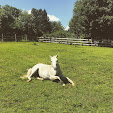Since I'm 5' 2", one of my mom's major sewing lessons was how to hem pants. Last summer, though, I decided to try sewing an actual garment (with a pattern). I started a spring dress with a white and pink leaf print for the body of the dress and a rose print for the yoke, hem, and sleeve trims. I still have to attach the sleeves. It's cute, even though it will have to be ironed a lot (it's made of quilting cotton).
I would like to continue sewing clothes in the future, since it's hard to find cute, petite-sized clothes that are a) age-appropriate and b) not cut for 12-year-olds. While it isn't hard to find such patterns, I've found that the sewing books targeted at teenagers/college students are mostly focused on sewing crafts (like making/decorating pillowcases) or making T-shirts into purses/skimpier shirts. Since ready-to-wear clothes are much cheaper than 50 years ago, even for students (you can get a $15 skirt at H&M), I can understand why there are fewer resources for learning to sew clothes.
But what about people who want to individualize their garments? I'm not just thinking about adjusting patterns (for non-average heights and/or body types), but customizing fabric choices and embellishments. There's also the appeal of making novelty garments, like Halloween costumes (since the ready-to-buy versions often look like industrial accidents). The decline in choices of fabric and fabric stores is also annoying - it's tough to find good selections of fabric that isn't quilting cotton or Polar Fleece.
Perhaps things might change for sewing. After all, knitting transformed very suddenly from being associated with stereotypical old ladies to a rather popular hobby among young women. And who knows, eventually the T-shirt chopping ladies might decide to construct garments from scratch.
